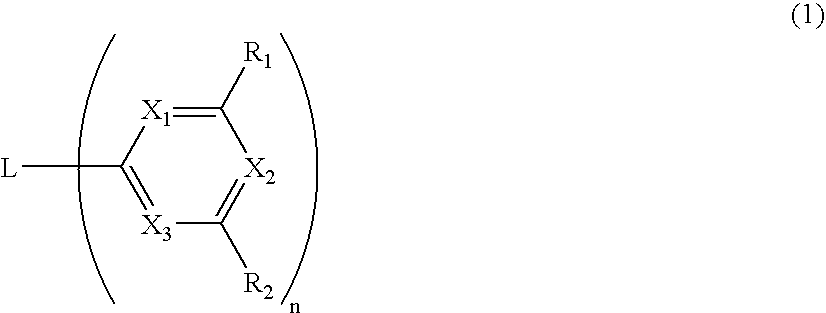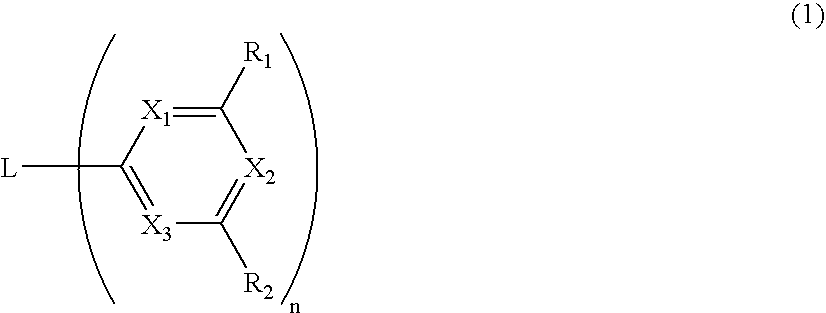Material for organic electroluminescence device and organic electroluminescence device utilizing the same
- Summary
- Abstract
- Description
- Claims
- Application Information
AI Technical Summary
Benefits of technology
Problems solved by technology
Method used
Image
Examples
synthesis example 1 (
Synthesis of Compound (H-1))
[0127] Compound (H-1) was synthesized as described below.
[0128] 10.6 g (100 mmol) of benzaldehyde and 12.0 g (100 mmol) of acetophenone were loaded into a 300-ml three-necked flask, followed by argon replacement. Next, 200 ml of ethanol and 10 ml of a 1N solution of sodium methoxide in methanol were added, and the whole was stirred at room temperature for 5 hours. After that, the temperature of the resultant was increased in an oil bath at 70° C., and the resultant was reacted for an additional 4 hours while ethanol was refluxed. Next, 14.1 g (60 mmol) of 3-bromobenzamidine hydrochloride and 8.00 g (200 mmol) of sodium hydroxide were added, the temperature of the whole was increased in an oil bath at 70° C., and the whole was reacted for 5 hours. After completion of the reaction, the precipitated product was separated by filtration and purified by means of silica gel column chromatography (developing solvent: methylene chloride), whereby 14.8 g of (Inte...
synthesis example 2 (
Synthesis of Compound (H-2))
[0131] Compound (H-2) was synthesized as described below.
[0132] 3.15 g (10 mmol) of tribromobenzene were dissolved in 40 ml of dehydrated ether. 7.8 ml (12.5 mmol) of a 1.6N solution of n-butyllithium in hexane were added to the solution under an argon atmosphere at −40° C., and the whole was subjected to a reaction at −40° C. to 0° C. for 1 hour. Next, the temperature of the resultant was cooled to −70° C., 4.8 ml (21 mmol) of triisopropyl borate were dropped to the resultant, and the whole was stirred at −70° C. for 1 hour. After that, the temperature of the resultant was increased to room temperature, and the resultant was subjected to a reaction for 6 hours. Further, 40 ml of 5% hydrochloric acid were dropped to the reaction solution, and then the whole was stirred at room temperature for 45 minutes. After the reaction solution had been separated into two layers, an organic layer was washed with a saturated salt solution and dried with anhydrous sod...
synthesis example 3 (
Synthesis of Compound (H-3))
[0136] Compound (H-3) was synthesized as described below.
[0137] 13.2 g (50 mmol) of 3,5-dibromobenzaldehyde, 6.1 g (50 mmol) of phenylboric acid, and 1.73 g (1.5 mmol, 3% Pd) of tetrakis(triphenylphosphine)palladium(0) were loaded into a 300-ml three-necked flask, and the inside of the container was replaced with argon. Further, 100 ml of 1,2-dimethoxyethane and 75 ml (3 eq) of a 2M aqueous solution of sodium carbonate were added, and the whole was refluxed under heat in an oil bath at 90° C. for 9 hours. After one night, ion-exchanged water and methylene chloride were added to extract an organic layer, and the layer was washed with ion-exchanged water and a saturated salt solution. The resultant was dried with anhydrous magnesium sulfate, and the solvent was removed by distillation. 10.3 g of a gray solid as a residue were purified by means of silica gel column chromatography (developing solvent: hexane / methylene chloride), whereby 9.1 g of (Intermedia...
PUM
| Property | Measurement | Unit |
|---|---|---|
| Length | aaaaa | aaaaa |
| Length | aaaaa | aaaaa |
| Length | aaaaa | aaaaa |
Abstract
Description
Claims
Application Information
 Login to View More
Login to View More - R&D
- Intellectual Property
- Life Sciences
- Materials
- Tech Scout
- Unparalleled Data Quality
- Higher Quality Content
- 60% Fewer Hallucinations
Browse by: Latest US Patents, China's latest patents, Technical Efficacy Thesaurus, Application Domain, Technology Topic, Popular Technical Reports.
© 2025 PatSnap. All rights reserved.Legal|Privacy policy|Modern Slavery Act Transparency Statement|Sitemap|About US| Contact US: help@patsnap.com



